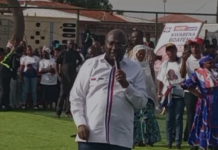
AngloGold Ashanti said it would resume dividend payments following a hiatus of more than three years, after lower operating and interest costs helped it nearly double free cash flow to $278m.
The company declared a dividend of approximately 10 US cents a share for 2016. Adjusted Headline Earnings (AHE) were $143m, or 35 US cents per share, compared with $49m, or 12 US cents per share in 2015. The sharp improvements in free cash flow and earnings were achieved through strong ongoing focus on cost and capital discipline, as well a higher gold price.
AngloGold Ashanti has since 2013 used ‘self-help’ measures including asset sales and efficiency improvements to reduce debt and improve balance sheet flexibility without diluting shareholders. It has, at the same time, improved safety and cash-flow margins across its 17-mine portfolio. The company has prioritised inward investment in high-return brownfield projects over acquisitions, as it seeks to improve the quality of its production base and extend mine lives.
“Production from our operations delivered a strong turn around in the second half of the year. We have again generated strong cash flows despite a volatile gold price, which has further strengthened our balance sheet and improved flexibility,” Chief Executive Officer Srinivasan Venkatakrishnan said. “We will continue to deliver on our strategy through the development of high-return, brownfield projects in order to continue to improve the underlying quality of our portfolio.”
All in Sustaining Costs (AISC) came in within revised guidance range at $986/oz, up from $910/oz in 2015. The AISC reflects continued cost discipline and weaker local currencies in some jurisdictions, offset by an increase in sustaining capital expenditure and inflation.
Production of 3.6Moz was within the original guidance for the year ended 31 December 2016 at a total cash cost of $744/oz, compared to 3.8Moz (excluding discontinued operations) at $712/oz in the prior year. Production was negatively impacted by weaker output from the South Africa mines due mainly to safety-related stoppages, lower grades from Kibali, a planned decrease in head grades at Tropicana and Geita, and no production contribution from Obuasi.
Both Mponeng and Moab Khotsong in South Africa delivered increased production over the prior year, along with Iduapriem and Siguiri in the Continental Africa Region, and Sunrise Dam in Australia. Mponeng delivered the best improvement, with a 16% increase in production and a 14% decrease in AISC year-on-year.
SECOND HALF
AngloGold Ashanti delivered a steady operating and financial performance in the second half of 2016, with production coming in at 1.9Moz compared to 2.0Moz in 2015. This operating result was achieved despite safety-related stoppages that impacted output by roughly 60,000oz in SA, planned lower grades at Geita and Tropicana, and the Obuasi mine having been on care and maintenance for last year. These negative production factors were partly offset by continued focus on tight cost control, a 14% higher realised gold price, and weaker currencies in some jurisdictions.
AISC for second half of 2016 was $1,058/oz, higher than the $897/oz for the second half of 2015 due mainly to lower gold ounces sold, higher overall cash costs, higher brownfields exploration costs, and increased sustaining capital expenditure.
Adjusted EBITDA of $767m, increased by 13% in the second half of 2016 compared to $679m in the second half of 2015, due to the 14% increase in the average gold price received which was partially offset by a 5% reduction in ounces sold over this period.
Proven and probable gold reserves at year end of 50.1Moz, substantially offsets depletion during the year.
SAFETY
The number of fatal accidents across the Group’s operations reduced by more than a third compared with 2015. Regrettably, however, six operating fatalities were recorded in South Africa during 2016 and another in Brazil. Despite these setbacks, significant safety milestones were achieved last year including a fatality free fourth quarter across all business units; one million fatality-free shifts at Mponeng, Kopanang and Moab Khotsong; as well as two-million fatality-free shifts for the Vaal River Region. Notably, Moab Khotsong achieved a full calendar year without a fatality in September and the Surface Operations unit achieved a full year with no lost-time injury.
While these milestones demonstrate relative success in the implementation of our safety strategy, we remain vigilant to ensure further gains in this most important area of the business.
There is no higher priority for AngloGold Ashanti than the safety of every one of its employees. We believe that through close cooperation among stakeholders and fair application of regulations with due regard to proportionality, as well as continued vigilance in an unpredictable operating environment, we can further improve safety performance.
OUTLOOK
Production guidance for 2017 year is estimated to be between 3.6Moz and 3.755Moz. Total cash costs are estimated to be between $750/oz and $800/oz and AISC between $1,050/oz and $1,100/oz at average exchange rates against the US dollar of 14.25 (Rand), 3.40 (Brazil Real), 0.75 (Aus$) and 16.50 (Argentina Peso), with oil at $58/bl average for the year, based on market expectations.
Capital expenditure is anticipated to be between $950m and $1,050m, with reinvestment at: Cuiaba, in Brazil, where a greater rate of ore reserve development is expected to improve mining flexibility hampered by geotechnical challenges in recent years; Iduapriem in Ghana, to strip waste rock from the Teberebie ore body to extend mine life, and lower cash costs; Geita, in Tanzania, to replace the mine’s original 20-year old power plant to ensure reliable electricity supply, and also continue the ramp-up of underground production in advance of depletion of open-pit ore in future; at Sunrise Dam, in Australia, where investment in plant modifications are expected to improve gold recoveries; and at Kibali, in the DRC, where additional ore reserve development will be conducted ahead of a ramp-up in underground production.
Both production and cost estimates assume neither labour interruptions or power disruptions, nor changes to asset portfolio and/or operating mines and have not been reviewed by our external auditors. Other unknown or unpredictable factors could also have material adverse effects on our future results and no assurance can be given that any expectations expressed by AngloGold A shanti will prove to have been correct.




